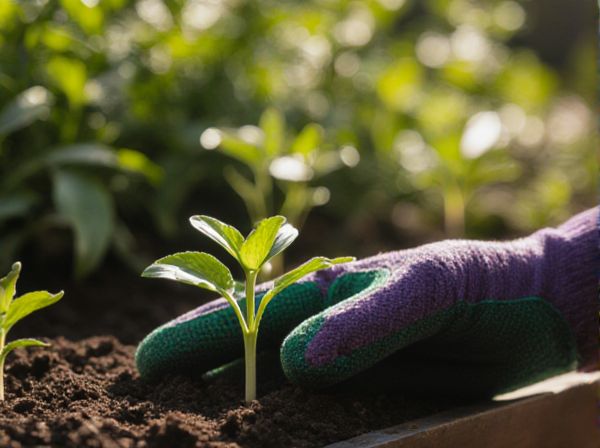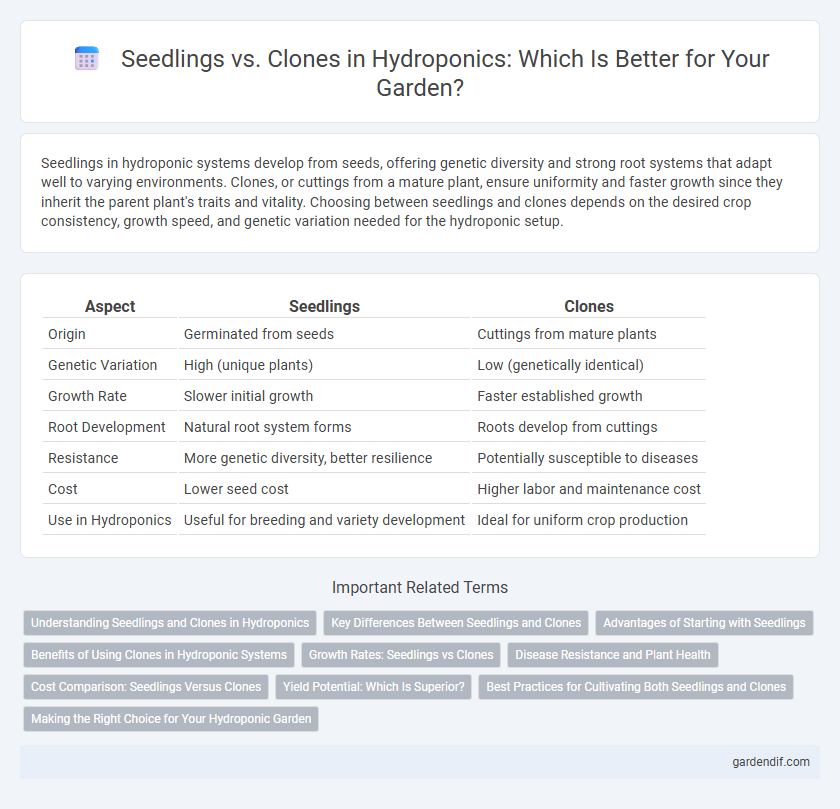
Seedlings vs Clones Illustration
Seedlings in hydroponic systems develop from seeds, offering genetic diversity and strong root systems that adapt well to varying environments. Clones, or cuttings from a mature plant, ensure uniformity and faster growth since they inherit the parent plant's traits and vitality. Choosing between seedlings and clones depends on the desired crop consistency, growth speed, and genetic variation needed for the hydroponic setup.
Table of Comparison
| Aspect | Seedlings | Clones |
|---|---|---|
| Origin | Germinated from seeds | Cuttings from mature plants |
| Genetic Variation | High (unique plants) | Low (genetically identical) |
| Growth Rate | Slower initial growth | Faster established growth |
| Root Development | Natural root system forms | Roots develop from cuttings |
| Resistance | More genetic diversity, better resilience | Potentially susceptible to diseases |
| Cost | Lower seed cost | Higher labor and maintenance cost |
| Use in Hydroponics | Useful for breeding and variety development | Ideal for uniform crop production |
Understanding Seedlings and Clones in Hydroponics
Seedlings in hydroponics originate from germinated seeds, offering genetic diversity and robust root development, which enhances early growth stages. Clones, derived from cuttings of mature plants, provide uniformity and faster production cycles due to identical genetic traits, ensuring consistent crop quality. Understanding the distinct growth patterns and maintenance requirements of seedlings and clones optimizes yield and resource efficiency in hydroponic systems.
Key Differences Between Seedlings and Clones
Seedlings in hydroponics are grown from seeds, offering genetic diversity and stronger root systems, while clones are cuttings from a mature plant, providing uniformity and faster growth cycles. Seedlings require longer development time but have greater resistance to diseases, whereas clones deliver consistent traits and predictable yields. Choosing between seedlings and clones depends on the desired balance of genetic variety, growth speed, and cultivation goals in hydroponic systems.
Advantages of Starting with Seedlings
Starting with seedlings in hydroponic systems ensures genetic diversity and stronger root development compared to clones. Seedlings typically resist diseases better and adapt more readily to changing environmental conditions. This advantage enhances crop resilience and overall yield quality in hydroponic cultivation.
Benefits of Using Clones in Hydroponic Systems
Clones in hydroponic systems provide uniformity in growth and yield by genetically replicating a successful mother plant, ensuring consistent quality and characteristics. They reduce the time needed for germination and early growth compared to seedlings, accelerating the production cycle. Hydroponic clones also minimize variability caused by seed genetics, leading to optimized nutrient uptake and enhanced disease resistance in controlled environments.
Growth Rates: Seedlings vs Clones
Clones in hydroponic systems often exhibit faster growth rates compared to seedlings due to their established root systems and genetic consistency. Seedlings require more time to develop initial roots and adapt to nutrient solutions, resulting in slower early-stage growth. Optimal hydroponic environments can reduce this gap, but clones generally maintain a growth advantage through uniformity and quicker maturation.
Disease Resistance and Plant Health
Seedlings in hydroponic systems often exhibit stronger disease resistance due to genetic variability, enhancing overall plant health and adaptability. Clones provide uniformity but may carry inherent vulnerabilities, increasing susceptibility to pathogens if the parent plant harbors diseases. Selecting vigorous seedlings reduces risk of widespread infections, promoting healthier crops and sustainable hydroponic yields.
Cost Comparison: Seedlings Versus Clones
Seedlings generally carry a lower initial cost compared to clones, as seeds are less expensive and easier to source from multiple suppliers. However, clones often lead to faster and more uniform plant development, potentially reducing overall growth time and improving yield consistency, which can offset their higher upfront price. In hydroponic systems, weighing the cost difference against factors like growth speed, genetic reliability, and labor investment is crucial for optimizing production efficiency.
Yield Potential: Which Is Superior?
Seedlings in hydroponic systems often demonstrate greater genetic diversity, allowing for stronger vigor and potentially higher yield variations, while clones provide uniformity and predictability in plant characteristics, making yield outcomes more consistent but sometimes less robust. Yield potential varies with the crop species and environmental control precision; seedlings can outperform clones in adapting to stress and vigorous growth, but clones ensure reliable flowering and fruiting schedules critical for commercial production. Optimal yield depends on specific hydroponic setup parameters and grower expertise in managing either seedlings or clones for maximum productivity.
Best Practices for Cultivating Both Seedlings and Clones
Best practices for cultivating seedlings in hydroponic systems include using high-quality seeds, maintaining optimal temperature (70-75degF), and ensuring consistent moisture without waterlogging. For clones, selecting healthy mother plants and using rooting hormones can enhance root development, while maintaining humidity levels around 70-80% promotes successful establishment. Both methods benefit from tailored nutrient solutions and precise pH control (5.5-6.5) to optimize growth and prevent nutrient deficiencies.
Making the Right Choice for Your Hydroponic Garden
Choosing between seedlings and clones for your hydroponic garden depends on growth speed, genetic consistency, and disease resistance. Seedlings offer genetic diversity and stronger root development, while clones provide uniformity and faster flowering times. Evaluate your crop goals and available resources to optimize yield and maintain plant health in a hydroponic system.
Seedlings vs Clones Infographic

 gardendif.com
gardendif.com